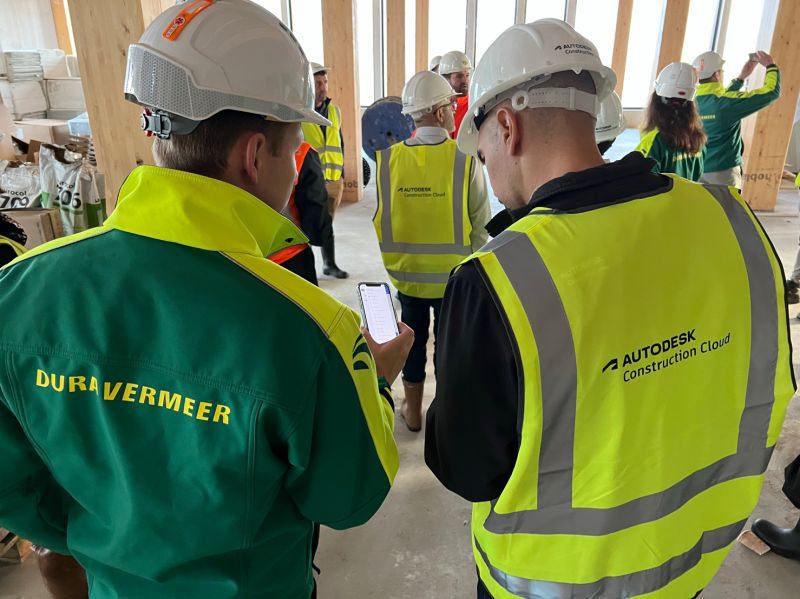
Sustainability is a key focus in today's construction sector. Construction companies are now expected to design and deliver structures that are more circular in their approach. Dura Vermeer is one company that is leading the way in this area.
This is one of their first projects of its kind – Alliander Westpoort, an entirely timber made structure. Dura Vermeer, a family-owned company, has 167 years of experience in construction, real estate, infrastructure and engineering. There are more than 2800 enthusiastic colleagues who work on a variety of projects, from complex housing to non-residential assets.
Dura Vermeer’s long-term goal is to become one of the Netherlands’ "top performing and digitalised construction companies.” And, in order to achieve this, they have taken great strides on their road to digitalisation. The team at Dura Vermeer is always looking for new and innovative ways to take on more challenging and complex projects.
Integrating digital technology into a construction project from the design phase can increase transparency and collaboration amongst all project stakeholders by leveraging Building Information Management (BIM). The results for Dura Vermeer speak volumes: a faster design process, a more effective and efficient construction process, and ultimately better-quality buildings.
The team at Dura Vermeer have been able to deliver a high-quality, sustainable structure by utilising prefabrication and offsite manufacturing on the Alliander Westpoort project. This structure is designed with disassembly in mind using more sustainable materials.
The goal of this project was to create a future-proofed building. "It needs to be built to the highest quality meaning our client will not need to scrap it or make major enhancements in a short time frame because it no longer meets the requirements expected of buildings in the future," says Kevin Vermeulen, Manager Digital Construction at Dura Vermeer.
The circular development, consisting of three buildings, provides space for offices, training facilities, warehouses and 500 parking spaces. At approximately 23,000 metres squared, it is designed for transparency in all forms. The final office building is designed to deliver a free and open space which creates a transparent working area that is connected to the environment.
Building with wood is the answer to creating flexible work buildings fit for the future. The hybrid structure has a concrete core with wooden columns that are combined with large wooden floors. This makes the design adaptable, efficient and resilient towards the future.

Data and document management is one of the most important aspects of any construction project. This is where Autodesk Construction Cloud plays a crucial role in Dura Vermeer’s ways of working. By establishing a common data environment in Autodesk Construction Cloud’s BIM 360 platform, the project’s construction teams – both internal and external – have managed documents and project data more efficiently and effectively.
Standardising document management is essential when it comes to collaborating across the supply chain effectively. For Dura Vermeer’s supply chain partners familiarising themselves with project requirements helps set clear expectations on subsequent projects when everyone is working to the same format.
Having a set standard also allows construction professionals to use technology to its full potential, as everyone is working towards the same goal and from the correct and up-to-date documentation.

What’s more is nearly 90% of all the architectural and constructional items on the Alliander Westpoort project have been elaborated with the use of BIM software solutions such as Autodesk’s Revit and Navisworks.
And nearly all construction partners on the project delivered IFC models using Autodesk solutions to support coordination in the pre-construction phase. This ultimately helped to reduce the number of clashes and errors that would have been identified on the construction site.
For Thom Dirks, Coordinator Digital Construction at Dura Vermeer, being able to conduct design meetings around the 3D model have been invaluable for collaboration and communication on the project. “We have used the 3D models for almost everything on this project,” reflects Thom. “It facilitates richer conversations between our project team members and our client by working in this way.”

Thom estimates that the team has gained savings of up to 25% when it comes to model coordination activities on the project. By using Autodesk’s design and construction ecosystem, the team can coordinate their efforts more effectively and efficiently, which saves both time but also money.
And looking at the project overall, it has been delivered in one short year which has no doubt been due to the adoption of modern methods of construction such as off-site manufacturing, prefabrication, and the use of digital workflows. Kevin reflects: “Would it have been possible to deliver the project without the use of construction management software? Yes. But it would have taken twice the amount of time!”
